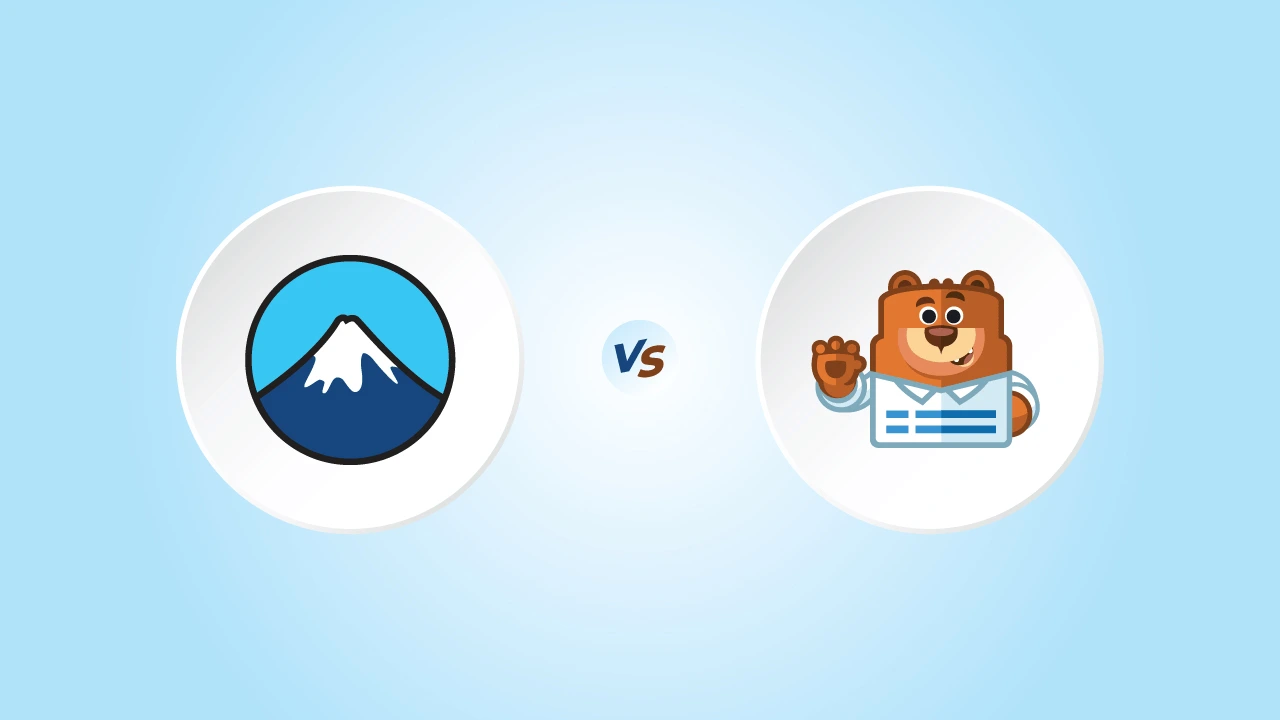If you are building a WordPress website, having a solid contact form is a must. Whether you need it for customer inquiries, job applications, newsletter signups, or event registrations, a well-designed form makes communication easy and efficient.
But with so many options, which form plugin should you choose?
Two of the most popular choices are Contact Form 7 and WPForms—and while both get the job done, they cater to very different users.
- If you want a free, no-frills solution, Contact Form 7 has been a go-to for years.
- If you prefer an easy-to-use, drag-and-drop builder with advanced features, WPForms might be the better choice.
So, which one is right for you?
In this guide, we will compare Contact Form 7 vs. WPForms side by side, breaking down their features, ease of use, pricing, and overall performance to help you make the best decision for your website.
⏰ 60-Second Summary
- WPForms is beginner-friendly with a drag-and-drop builder; Contact Form 7 requires manual shortcode setup.
- WPForms includes advanced features like conditional logic & payments; Contact Form 7 is basic and relies on add-ons.
- WPForms offers built-in styling & templates; Contact Form 7 needs custom CSS for design changes.
- WPForms loads scripts only when needed (faster); Contact Form 7 loads scripts site-wide (slower).
- Contact Form 7 is free but lacks support; WPForms has free & paid versions with priority support.
- Choose WPForms for ease & features, or Contact Form 7 for a free, lightweight option.
Overview of Contact Form 7 and WPForms
When it comes to WordPress form plugins, Contact Form 7 and WPForms are two of the most widely used options. While both help you create contact forms, they take very different approaches.
Let’s take a closer look at their history, popularity, and who they are best suited for.
Contact Form 7: A Classic, No-Frills Form Plugin
Launched in 2007, Contact Form 7 is one of the oldest and most downloaded WordPress contact form plugins. With over 5 million active installations, it’s been a go-to choice for many website owners who need a simple, no-cost solution for adding contact forms.
Who Uses Contact Form 7?
- Developers & Experienced Users – Since it relies on shortcodes and manual setup, users with coding experience find it easy to customize.
- Minimalists – If all you need is a basic contact form without extra features, this plugin does the job.
- Budget-Conscious Users – It’s 100% free, making it a great choice for those who don’t want to pay for a premium form builder.
| Pros: | Cons: |
|---|---|
|
|
WPForms: A Modern, User-Friendly Form Builder
WPForms was launched in 2016 by Syed Balkhi and the team behind WPBeginner. Unlike Contact Form 7, WPForms was built to be beginner-friendly, offering an easy drag-and-drop interface. It quickly gained popularity and now boasts over 5 million active installations with a 4.9-star rating.
Who Uses WPForms?
- Beginners & Non-Technical Users – The drag-and-drop interface makes it super easy to create forms without touching code.
- Business Owners & Agencies – WPForms offers advanced features like payment integration, conditional logic, and multi-step forms, making it perfect for business websites.
- Marketers – The plugin includes features like email marketing integrations and survey forms, making it a solid choice for lead generation.
| Pros: | Cons: |
|---|---|
|
|
Whether you need customization, integrations, or troubleshooting, our team has you covered! Let’s build a seamless form experience for your site.
Key Features Compared: WPForms vs. Contact Form 7
Ease of Use:
Which One is More User-Friendly?
When choosing a WordPress contact form plugin, ease of use is a big factor—especially if you are not a developer. A form builder should be intuitive and simple to set up without requiring technical knowledge.
Let’s see how Contact Form 7 and WPForms compare in terms of usability.
Contact Form 7: Manual Setup with Shortcodes
If you are looking for a straightforward, code-based solution, Contact Form 7 does the job—but it’s not the easiest to use, especially for beginners.
- Form Creation Process: Instead of a visual interface, you get a basic text editor where you manually configure form fields using shortcodes.
For example, if you want to add a text field, you will need to enter something like:
[text your-name placeholder “Your Name”] - Embedding Forms: After creating a form, you will need to copy a shortcode and paste it into your page, post, or widget area.
- Customization Challenges: While you can style forms with CSS, there’s no built-in design editor, making it tricky for non-coders to customize.
| Good for | Not ideal for: |
|---|---|
| Developers and users comfortable with basic coding. | Beginners who prefer a visual editor. |
WPForms: Drag-and-Drop Simplicity
WPForms was built with ease of use in mind. It features a drag-and-drop builder, making it incredibly intuitive—even for beginners.
- Form Creation Process: Instead of dealing with shortcodes, you get a visual editor where you can simply drag and drop form fields. Want to add a name field? Just drag it into place—no coding required.
- Pre-Built Templates: WPForms also provides ready-made form templates (like contact forms, surveys, and payment forms), so you don’t have to start from scratch.
- Embedding Forms: Once your form is ready, you can insert it anywhere using the WPForms block in the WordPress editor—no need to mess with shortcodes.
| Good for | Not ideal for: |
|---|---|
| Beginners, business owners, and anyone who wants an easy setup. | Users who prefer a lightweight, code-based solution. |
Winner: WPForms
When it comes to ease of use, WPForms is the clear winner. Its drag-and-drop builder, visual editor, and pre-made templates make it far more beginner-friendly than Contact Form 7.
Features and Functionality:
Which Plugin Offers More?
When choosing a contact form plugin, it’s not just about ease of use—you also need the right features to match your needs. Some websites need a simple contact form, while others require advanced options like multi-step forms, file uploads, and payment integrations.
Let’s break down what Contact Form 7 and WPForms offer in terms of basic and advanced features.
Basic Features Comparison
Form Creation & Customization
- Contact Form 7: Uses a manual, shortcode-based system for form creation. You’ll need to configure fields using code-like tags. No built-in visual editor for customization.
- WPForms: Provides a drag-and-drop form builder, making customization easy. Comes with pre-built templates for faster form creation.
Spam Protection
- Contact Form 7: Supports reCAPTCHA, Akismet, and other third-party spam protection tools—but you have to manually set them up.
- WPForms: Offers built-in spam protection, including reCAPTCHA, hCaptcha, honeypot fields, and custom CAPTCHA options.
Winner (Basic Features): WPForms
WPForms is much easier to use, while Contact Form 7 requires manual setup and shortcodes.
Advanced Features Comparison
Conditional Logic (Show/Hide Fields Based on User Input)
- Contact Form 7: No built-in support for conditional logic. You need third-party add-ons.
- WPForms: Has built-in conditional logic, allowing you to create dynamic forms that adjust based on user responses.
Multi-Step Forms (Break Long Forms into Steps)
- Contact Form 7: No built-in multi-step functionality—you need to install an extra plugin.
- WPForms: Includes multi-step form support (Pro version) for better user experience.
File Uploads & Payment Integrations
- Contact Form 7: Supports file uploads but requires manual setup. No built-in payment integration (requires third-party plugins).
- WPForms: Allows file uploads with drag-and-drop functionality. Also integrates with PayPal, Stripe, and Authorize.Net for payments (Pro version).
CRM & Email Marketing Integrations
- Contact Form 7: Works with some email marketing tools via third-party add-ons.
- WPForms: Direct integrations with Mailchimp, Constant Contact, AWeber, HubSpot, and more.
Winner (Advanced Features): WPForms
WPForms is more feature-rich, offering built-in conditional logic, multi-step forms, and direct integrations with email marketing and payment gateways.
Design and Customization:
Which Plugin Makes Better-Looking Forms?
A contact form isn’t just about functionality—it should also look good and match your website’s design. Whether you want a simple contact form or something more customized, the right plugin should make styling easy.
Let’s compare how Contact Form 7 and WPForms handle design and customization.
Contact Form 7: Basic Design, Requires Manual Styling
Contact Form 7 keeps things minimal and functional—but that also means it lacks built-in design options.
- Form Appearance: By default, forms are plain and unstyled, adopting your theme’s default form styling.
- Customization: To change fonts, colors, or layouts, you’ll need to write custom CSS.
- Templates: No built-in templates—every form must be built manually.
- Form Layout: Since it’s HTML-based, form fields stack vertically by default unless manually adjusted with CSS.
| Good for | Not ideal for: |
|---|---|
| Developers or users comfortable with CSS. | Non-technical users who want an easy way to style forms. |
WPForms: Visually Appealing & Customizable
WPForms makes form design much easier and more flexible, even if you have no coding experience.
- Form Appearance: Forms are well-designed by default, with padding, spacing, and responsiveness already built in.
- Customization: Includes a visual styling panel, so you can change colors, fonts, and layouts without writing code.
- Templates: Comes with pre-designed templates for contact forms, registration forms, surveys, and more.
- Form Layout: Supports multi-column layouts and inline fields, making it easier to create well-structured forms.
| Good for | Not ideal for: |
|---|---|
| Beginners, business owners, and anyone who wants a great-looking form without coding. | Users who prefer full manual control via code. |
Winner: WPForms
When it comes to design and customization, WPForms is the clear winner.
- For non-technical users, WPForms makes styling easy with its built-in templates and visual customization tools.
- For developers, Contact Form 7 provides full control—but at the cost of extra work, requiring custom CSS for even simple design changes.
Performance and Speed:
Which Plugin is More Efficient?
Website speed is an important element for SEO and user experience, and a poorly optimized contact form plugin can slow down your site.
Let’s see how Contact Form 7 and WPForms impact performance.
Contact Form 7: Lightweight but Can Be Slow
- Minimalist Approach: Contact Form 7 is a very lightweight plugin—it doesn’t come with a fancy builder or extra features that could slow down your site.
- Performance Issues: However, it can negatively impact page speed because it loads JavaScript and CSS files on every page, even if a form isn’t present.
- No AJAX Submissions (By Default): Contact Form 7 reloads the entire page when a user submits a form, which can slow down performance. AJAX submission (which prevents full-page reloads) is available but requires extra setup.
| Good for | Not ideal for: |
|---|---|
| Simple sites that want a lightweight contact form plugin. | Websites that need fast, optimized form submissions. |
WPForms: Optimized for Speed and Efficiency
- Built for Performance: WPForms is optimized for speed, ensuring it doesn’t slow down your site.
- Smart Asset Loading: Unlike Contact Form 7, WPForms only loads scripts and styles when a form is present on a page, reducing unnecessary requests.
- AJAX Form Submission: Forms can be submitted without reloading the page, making it faster and providing a better user experience.
- Optimized Code: WPForms’ development focuses on clean, efficient code, reducing server load.
| Good for | Not ideal for: |
|---|---|
| Any site that values speed and smooth user experience. | Users looking for a completely free and ultra-minimalist option (since some optimizations require WPForms Pro). |
Winner: WPForms
WPForms is the better choice for performance and speed.
While Contact Form 7 is lightweight, its lack of AJAX submissions and inefficient script loading can make your site feel sluggish. WPForms, on the other hand, loads assets only when needed and supports AJAX submissions, making it the faster and more optimized option.
Pricing and Value:
Which Plugin Gives You More for Your Money?
When choosing a contact form plugin, pricing is also an important factor—especially if you are on a budget. While both Contact Form 7 and WPForms offer free versions, their pricing models and value offerings are quite different.
Let’s break it down.
Contact Form 7: Completely Free, But Limited
- Free Forever – Contact Form 7 is 100% free, making it an attractive option for those who don’t want to spend money on a form plugin.
- No Premium Version – Unlike WPForms, there’s no official pro version—you get what you get.
- Extra Features Require Third-Party Add-ons – If you need advanced features like file uploads, multi-step forms, or integrations, you’ll need to install extra plugins, some of which cost money.
- No Dedicated Support – Since it’s free, support is limited to community forums, which may not always provide quick solutions.
Best for: Users who only need a basic contact form and don’t mind manual setup.
WPForms: Free and Paid Plans for Extra Features
WPForms offers a freemium model, meaning there’s a free version (Lite) and paid plans with premium features.
WPForms Lite (Free Version)
- Beginner-friendly – Comes with a drag-and-drop builder and basic contact form functionality.
- Includes Spam Protection – Built-in honeypot spam prevention.
- Limited Features – No conditional logic, no file uploads, no payment integration.
Best for: Beginners who need a simple, user-friendly contact form without advanced features.
WPForms Premium Plans (Paid Versions)
If you need more advanced features, WPForms offers four pricing tiers:
| Plan | Price (Per Year) | Best For |
|---|---|---|
| Basic | $50 | Simple forms with spam protection |
| Plus | $100 | Email marketing integrations (Mailchimp, AWeber, etc.) |
| Pro | $200 | Multi-step forms, payments, surveys, and conditional logic |
| Elite | $299.50 | All features + unlimited site usage |
Winner: It Depends on Your Needs
- Best for Budget Users → Contact Form 7 (If you only need a simple, free contact form and don’t mind manual setup.)
- Best for Features & Value → WPForms (If you want an easy-to-use builder with advanced functionality and integrations.)
Support and Documentation:
Which Plugin Has Better Help Resources?
When you run into issues with your form plugin, having access to reliable support can save you a lot of time and frustration.
Let’s compare the support options for Contact Form 7 and WPForms to see which one provides better assistance.
Contact Form 7: Limited Support, Community-Based
Since Contact Form 7 is completely free, it doesn’t come with dedicated customer support. Instead, users rely on:
- Community Forums – You can ask questions in the WordPress.org support forum, but responses depend on community members and are not always timely.
- Documentation – Contact Form 7 has a knowledge base with setup guides, but it assumes some level of technical know-how.
- No Priority Support – If something breaks on your site, you’re on your own—there’s no option for direct support from the WordPress plugin developer.
WPForms: Dedicated Support for Free & Paid Users
WPForms offers much better support options, especially for premium users.
- Free Users (WPForms Lite) – Access to an extensive knowledge base and WordPress.org forums for basic troubleshooting.
- Premium Users – Paid users get priority email support from WPForms’ dedicated customer service team.
- Extensive Documentation – WPForms has a detailed help center with step-by-step guides, FAQs, and troubleshooting tips.
- Faster Response Times – Pro users typically get responses within 24 hours on business days.
| Good for | Not ideal for: |
|---|---|
| Beginners, businesses, and anyone who values quick, professional support. | Users who prefer completely free solutions and don’t need direct support. |
Winner: WPForms
If support is important to you, WPForms is the clear winner.
- Contact Form 7 relies on community support, which can be slow and unreliable.
- WPForms provides priority support for premium users and has a huge knowledge base to help troubleshoot issues.
Security and Reliability:
Which Plugin Keeps Your Data Safer?
Security is a big deal when dealing with contact form plugins. Since forms collect user data, they can be a target for spam, hacking attempts, or data breaches. Let’s compare how Contact Form 7 and WPForms handle security, spam protection, and GDPR compliance.
Contact Form 7: Basic Security with Manual Setup
- Security Updates – Contact Form 7 receives regular updates, but since it’s a free plugin, security patches may not be as frequent as premium plugins.
- Spam Protection – Supports reCAPTCHA, Akismet, and Honeypot spam filtering, but you have to manually set them up.
- Data Handling – Contact Form 7 doesn’t store form submissions in the WordPress database, which means no risk of data leaks—but also no backup of messages.
- GDPR Compliance – The plugin doesn’t store personal data, so it’s technically GDPR-friendly, but it doesn’t offer built-in GDPR consent checkboxes—you have to add them manually.
| Good for | Not ideal for: |
|---|---|
| Users who want a lightweight plugin that doesn’t store form submissions. | Businesses that need secure data storage and built-in spam protection. |
WPForms: Stronger Security & Built-in Protections
- Security Updates – WPForms is actively maintained with frequent security updates to address vulnerabilities.
- Spam Protection – Built-in spam filters like Honeypot, Google reCAPTCHA, hCaptcha, and custom CAPTCHA for better protection.
- Data Handling & Storage – WPForms stores form submissions in your WordPress database (Pro version), but you can enable GDPR-friendly options to prevent storing sensitive data.
- GDPR Compliance – Comes with a built-in GDPR enhancement that lets users disable data tracking and add consent checkboxes without extra coding.
| Good for | Not ideal for: |
|---|---|
| Businesses, eCommerce sites, and anyone who needs secure form submissions and strong spam protection. | Users who want a completely free solution with minimal security setup. |
Winner: WPForms
WPForms is the more secure option.
- Contact Form 7 requires manual security setups and doesn’t store data, which can be good for privacy but limits functionality.
- WPForms has built-in security features, stronger spam protection, and GDPR tools, making it the better choice for businesses and websites handling user data.
Which Plugin is Best for You?
Now that we have seen Contact Form 7 vs. WPForms across all key areas, it’s time to make a decision. Which one is the best fit for your website?
It all comes down to what you need from a contact form plugin. Here’s a quick guide to help you decide.
Choose Contact Form 7 if…
- You need a completely free and lightweight form plugin.
- You are comfortable working with shortcodes and manual customization.
- You don’t need advanced features like conditional logic, file uploads, or multi-step forms.
- You want a minimalistic plugin that doesn’t store form submissions (good for GDPR compliance).
- You are okay with basic spam protection that requires some manual setup.
Best For:
- Developers & advanced WordPress users.
- Simple websites that only need a basic contact form.
- Users who don’t want to pay for premium features.
Choose WPForms if…
- You want an easy-to-use, drag-and-drop builder with no coding required.
- You need pre-built form templates to quickly create different types of forms.
- You want built-in spam protection (Honeypot, CAPTCHA, reCAPTCHA, hCaptcha).
- You need advanced features like conditional logic, file uploads, and payment integration.
- You are looking for secure data storage and GDPR-compliant options.
- You prefer priority support and frequent security updates.
Best For:
- Developers & advanced WordPress users.
- Simple websites that only need a basic contact form.
- Users who don’t want to pay for premium features.
Conclusion
Both Contact Form 7 and WPForms are powerful WordPress plugins for creating contact forms, but they cater to different types of users and needs.
If you are looking for a free, lightweight, and highly customizable solution and don’t mind using shortcodes or additional plugins for extended functionality, Contact Form 7 is a solid choice. However, it lacks a visual builder, built-in integrations, and advanced features, which may require extra effort for non-developers.
On the other hand, if you prefer a beginner-friendly, feature-rich, and drag-and-drop form builder with built-in templates, spam protection, and seamless integrations, WPForms is the better option. While it has a free version, its premium plans unlock powerful features like payment processing, conditional logic, and marketing automation.
Ultimately, your choice depends on your needs—Contact Form 7 is ideal for developers and minimalists, while WPForms is perfect for businesses and beginners looking for an all-in-one solution. If you’re working with a WP development agency, they can help you integrate the best form plugin based on your website’s specific requirements.
Our WordPress experts at cmsMinds can help you set up and customize the perfect form for your website.





